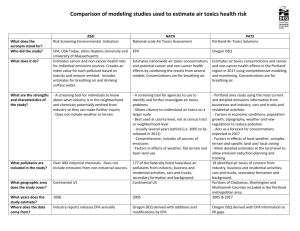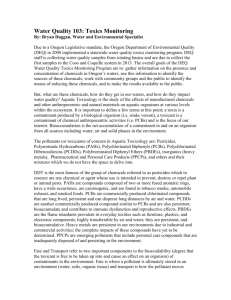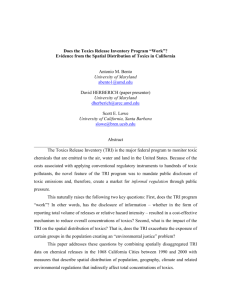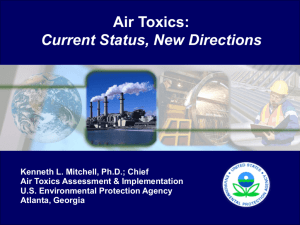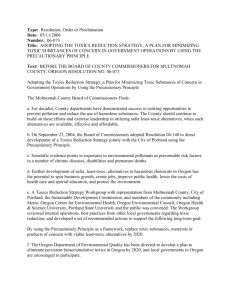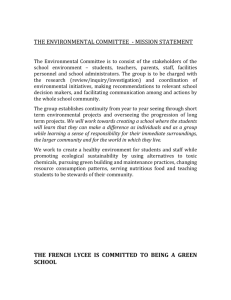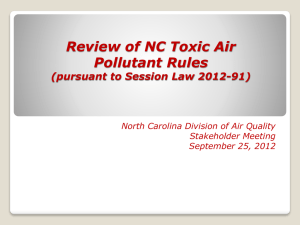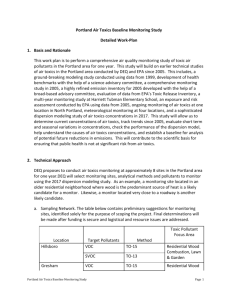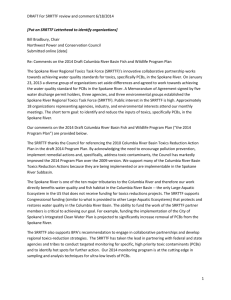view presentation
advertisement
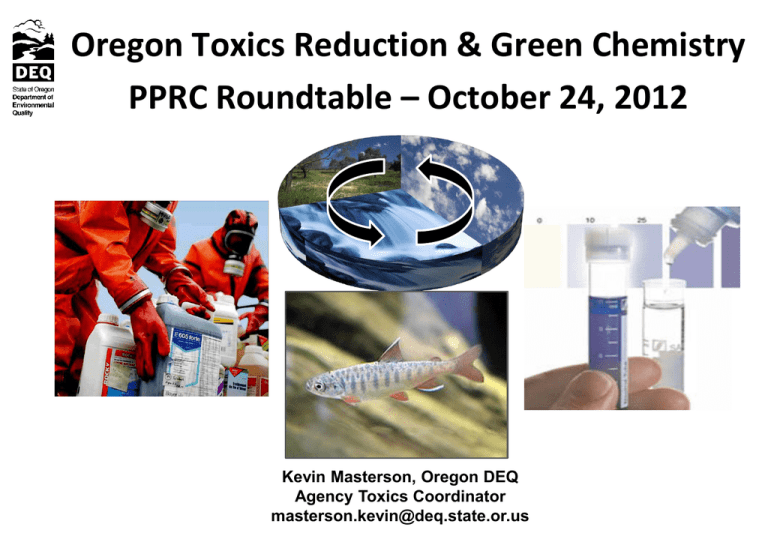
Oregon Toxics Reduction & Green Chemistry PPRC Roundtable – October 24, 2012 Kevin Masterson, Oregon DEQ Agency Toxics Coordinator masterson.kevin@deq.state.or.us Why Develop an Agency-Wide Toxics Reduction Strategy? • Toxics don’t respect program boxes: – Pollutants released to air deposit to land run off to water • Gets us beyond chemical-by-chemical approach • Increases efficient use of resources by taking a more integrated and strategic approach • Complements existing DEQ toxics programs – E.g., “alternative implementation strategies” for WQ Human Health Toxics Standards Recent History of Key Oregon ore Regional Initiatives • 2009-10 DEQ develops “Focus List” of priority chemicals Columbia Basin Toxics Reduction Action Plan released • 2011 DEQ Toxics Reduction Strategy drafted & presented Portland State University’s chem policy white paper • 2012 Oregon Governor signs executive order promoting green chemistry and toxics reduction DEQ Toxics Reduction Strategy: Identifying High-Priority Toxics • DEQ developed “Focus List” of 51 chemicals or groups of chemicals – Based on existing agency priority lists – Diverse range of chemicals – Overlaps with priorities of other organizations • • EPA Chemical Action Plans Large national retailers – List is not static – expect changes over time OREGON DEQ TOXICS FOCUS LIST (2012) CHEMICAL CATEGORY Combustion & Petroleum ByProducts: Consumer Product Constituents: Current Use Pesticides: Flame Retardants and Industrial Intermediates: Legacy Pesticides: Metals: CHEMICAL S Polycyclic Aromatic Hydrocarbons (PAHs) Dioxins and Furans Napthalenes Phthalates Triclosan Bisphenol A DEET Diazinon Malathion Chlorpyrifos Permethrin 4-Nonyphenol (and Nonyphenol Ethoxylates) Atrazine Carbaryl Trifluralin Pentachlorophenol Chlorothalonil Diuron Glyphosate Hexachlorocyclohexa ne (HCH), gamma(Lindane) Polychlorinated Biphenyls (PCBs) 2,4-D Propoxur (Baygon) Pendamethalin Aldrin Methoxychlor Polybrominated Diphenyl Ethers (PBDEs) Dieldrin Heptachlor (& Heptachlor epoxide) Mercury (and methylmercury) Lead Tetrachloroethylene DDT (and metabolites) Hexachlorocyclohexa ne, beta(beta-BHC) Copper Chlordane (and metabolites) Hexachlorobenzene Cadmium Chromium Nickel Benzene Manganese Ethylbenzene Silver Trichloroethylene Volatile Organic Compounds (VOCs): Toluene Ammonia Formaldehyde Hexachlorocyclohexa ne, alpha- (alphaBHC) Arsenic Dichlorobenzene, 1,4(Dichlorobenzene-p) What Types of Actions are Included in the Toxics Reduction Strategy? • 25 Actions Included in Strategy – Improving integration and prioritization of toxics reduction activities – Enhancing effective existing reduction efforts – Addressing identified toxics reduction needs – Assessing and characterizing toxics in Oregon • Overarching theme collaboration and partnerships DEQ Identified 5 Priority Short-term Actions in 2012 • Short-term priority actions complement and support: – Columbia River Toxics Reduction Priorities – Green Chemistry Executive Order • Other Toxics Strategy actions remain relevant – Work will occur as resources allow – Strategy will be regularly assessed and refined Short-Term Priority Actions: Integrating Technical Assistance • Combining efforts of multiple DEQ programs and agencies to achieve common goals for 2 industry sectors (Action #1) – Identify viable safer alternatives through assessment tools & resources – Identify needs for green chemistry research and incentives Short-Term Priority Actions: Leveraging Market Forces • Increase state government purchasing of safer chemical alternatives using guidelines (Action #2) • Work with retailers and 3rd party certifiers to increase availability and visibility of low toxic consumer products (Action #3) Short-Term Priority Actions: Pesticide Stewardship Partnerships • Build on program that uses environmental monitoring data to focus collaborative voluntary actions (Action #4) – Existing stewardship tools and expertise – Watershed-level data provide measures of success What Outcomes Are We Looking For? Hood River Pesticide Stewardship Partnership Results Early Spring Chlorpyrifos - Lower Neal Creek Average Chronic WQS Acute WQS Average (ug/l) 0.400 0.350 0.300 0.250 0.200 0.150 0.100 0.050 0.000 2000 2001 2002 2003 2004 2005 Year 2006 2007 2008 2009 2010 Short-Term Priority Actions Collecting Unwanted Pesticides • Establish Statewide Pesticide Collection Program (Action # 5) – Unlike WA, no dedicated funding source in Oregon – Periodic events show increasing quantities – Assembled partners to identify funding sources and coordinated plan 2012 Oregon Executive Order: Promoting Green Chemistry • Executive Order No. 12-05: “Fostering Environmentally-Friendly Purchasing and Product Design” • Signed April 27, 2012 • Lead agencies identified: – Department of Environmental Quality – Department of Administrative Services – Business Oregon (economic development) Oregon Executive Order 12-05: • 4 Key Elements of Order Develop outreach strategy for businesses to apply green chemistry (select 2 sectors) Develop proposals to incentivize green chemistry through new or existing programs Strengthen demand for low toxicity products through state purchasing practices and guidelines Develop inter-agency toxics reduction strategy to ensure efficiencies and address gaps Next Steps & Milestones • Present Columbia Basin priority actions to governmental executives on Nov. 1, 2012 • Present update on DEQ toxics strategy and priority actions to Environmental Quality Commission in December, 2012 • Executive order implementation start pilot purchasing initiative for cleaning products by end of 2012 • 2013 Full implementation of 5 short-term priority actions in OR toxics reduction strategy
